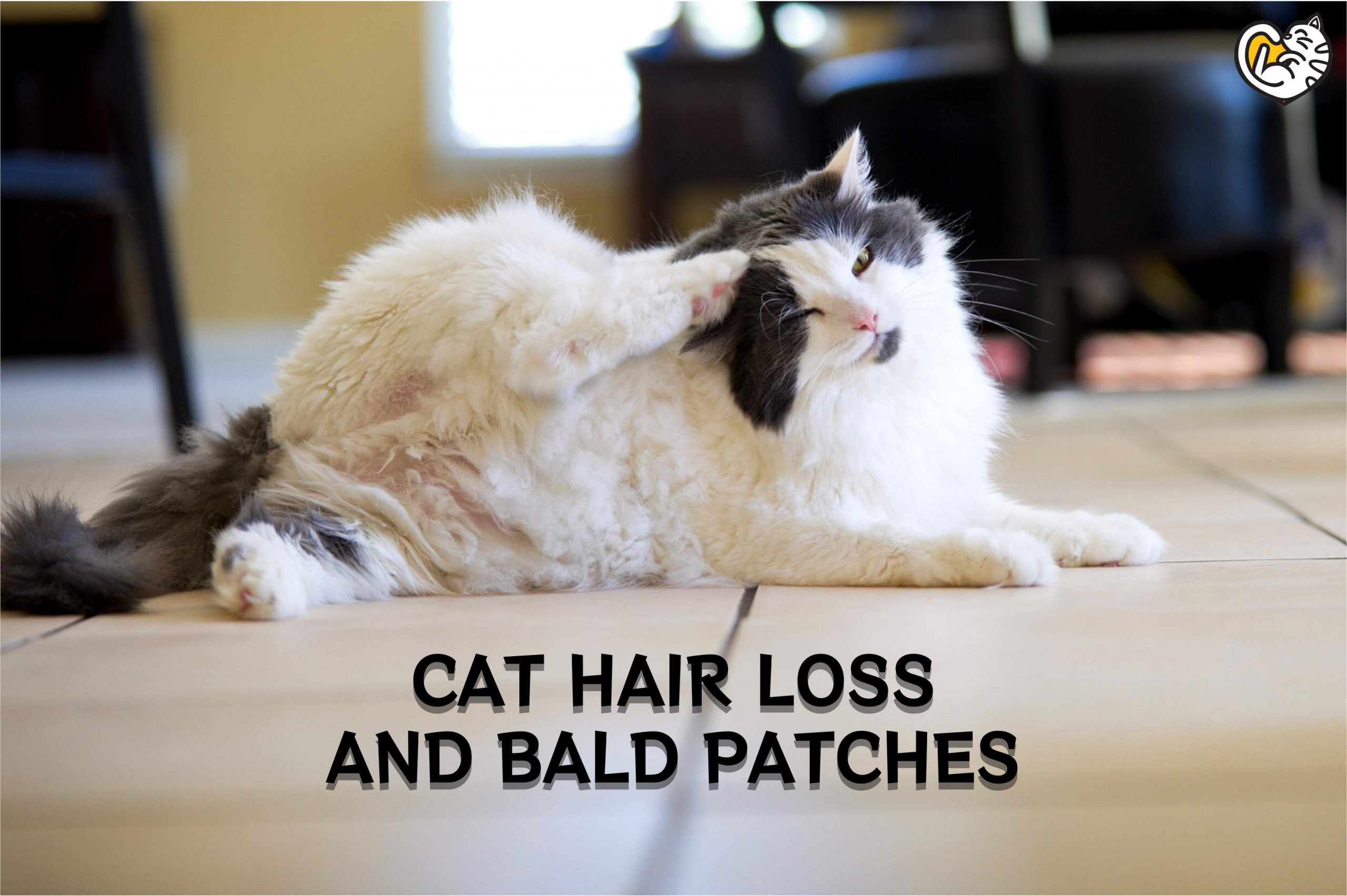Cat Hair Loss and Bald Patches

Cats are adorable and their beautiful glossy hair is a big part of their appeal; it can be frustrating when you know that your cat is losing its hair. Cats shed their hair regularly, which is normal. But if the hair loss is severe and you notice a bald patch on your cat, this can cause concern. If this is your worry, keep reading. This article will discuss everything you need to know about cat hair loss and bald patches.
Want your cat to live the longest, healthiest, and happiest life?
It starts with what’s in their bowl.
Every meal is a chance to give your cat more energy, fewer vet visits, a shinier coat, and a longer, happier life by your side.
Choose food that truly understands your cat’s needs.
Choose Grace Cat. 🐾
Malaysia’s First Freeze-Dried Complete Meal With Krill Oil & Postbiotic
Cat Shedding – How much is too much?
Shedding is a natural part of every cat’s existence, and owners need to accept this as a fact. Cats replenish their fur and keep themselves in good shape by shedding. Generally, wild cats shed their hair twice a year, once in the spring to shed their winter undercoat and again in the fall to prepare for the new coat. Domesticated or indoor cats, on the other hand, are usually exposed to artificial summer air-conditioning or winter heating. Because of this, their bodies can be confused by the environmental temperatures, and they continuously shed.
Cats shed to get rid of dead hair on their bodies. This hair should be removed as it might irritate the skin. Shedding means the cat is in good health, but if the shedding is significant or if you notice your cat is losing hair more frequently in huge amounts, to the point where you notice a bald patch, this should cause concern for you to see a veterinarian. There are different types of cat hair loss; in the following paragraphs, we will look at the types of cat hair loss.
Types of Hair Loss or Alopecia
Alopecia is a medical term for hair loss or baldness; it is the complete or partial absence of hair in the areas where it is normally found. Hair loss is a symptom, and the underlying cause should be identified before treatment can begin. There are two types of hair loss, it can either be congenital or acquired:
Congenital Alopecia
Congenital alopecia means the hair loss presents at birth. It can be obvious at birth or shortly after birth. Or, your cat may be born with a normal coat and later have local hair loss when it grows up. This kind of hair loss may or may not be hereditary. An example of a cat breed with hereditary alopecia is Sphynx, they are born without hair and never grow any.
Acquired Alopecia
This is the type of hair loss that the cat is born with a normal hair coat. It has normal hair follicles which can produce normal hair. Some diseases can affect and destroy hair follicles, making it difficult for hair to grow. The condition can cause discomfort (pain or itching), leading to trauma and hair loss in a cat. Acquired hair loss can be inflammatory or non-inflammatory (hormonal); inflammatory disorders are the most common cause of hair loss.
General Reasons for Cat Hair Loss and Bald Patches
There are many reasons for cat hair loss, like unhealthy diet, allergies and fungal infections. They are usually simple to diagnose and cure. Sometimes the hair loss can be due to excessive grooming with underlying conditions. The general reasons include:
Unhealthy Diet
Cat hair requires a constant supply of important nutrients in order for it to remain fixed in the hair follicles. So, a poor diet can cause cat hair loss. If you regularly feed your cat unhealthy foods, such as table scraps or food with excessive sodium, it will become ill, and one of the symptoms of this condition is hair loss.
Fungal Infections
Infection-induced cat hair loss happens when fungal microorganisms enter the skin’s protective barriers and grow within the surface layer of the skin. This harms the hair follicles and causes hair loss. Cat alopecia is commonly caused by fungi such as ringworm, especially in younger cats or those with underlying health problems.
Allergies (Especially Due to Fleas)
Some cats suffer from skin allergies, leading to hair loss. Cat usually gets infested by fleas at some point, some cats are allergic to the antigens found in flea saliva. This can make them itch terribly, and many cats will lick their fur to relieve the itch. Over-grooming might lead to bald spots. Mange, mites, scabies, food allergies and environmental allergies can also cause itching and excessive licking.
Stresses
Cats are highly sensitive beings that easily become stressed. Even the least change in their environment can cause stress to them, which can result in physical changes. When cats are exposed to stress for an extended period, they can develop compulsive behaviours that harm their health. Psychogenic alopecia is a common condition in cats that causes hair loss due to excessive grooming. This usually occurs when a cat is stressed, leading it to continuously lick different places of the body, which eventually leads to hair loss. The hair loss happens only on the body parts that the cat’s tongue can reach.
Pain
Sometimes, the cause of cat over-grooming is not itching or stress, but pain. For example, a cat with arthritis may constantly lick its achy joint because it is painful. Licking may help to relieve the discomfort.
Tumour or Cancer
Feline paraneoplastic alopecia is a skin disorder resulting in hair loss. The alopecic skin has a shiny and smooth appearance. This is a rare symptom that usually indicates a sign of internal tumours. Most cats with paraneoplastic alopecia develop pancreatic disease.
Causes of Cat Hair Loss According to Specific Area
Sometimes, cat hair loss happening in specific areas can be a good indication of the underlying causes:
Cat Bald Patches Above the Eyes
As cats grow in size and their hair thins out, hair loss above their eyes is common. Though cat hair loss can be inherited, other causes include fungal infection, fleas, mites and stress. In cats, facial hair loss is a natural part of ageing. It commonly appears above the eyes, and in the area between the eyes and the ears. Bald patches above the eyes are common in shorthaired kittens with a dark coat. As they grow, certain parts may appear weak. This thinning of the coat can continue until the cat is three years old.
Cat Hair Loss On the Ears
If your cat is losing hair around its ears or has a bald spot on its head, it is time to examine what is going on. Ear mites, scientifically known Otodectes cynotes, can lead to extreme itching and cat hair loss on the ears and head, among other things. These mites are easily transmitted to other cats, dogs and, in some cases, to people. Although the mites are barely visible to the naked eyes, it is not hard to identify. The most common symptoms include hair loss and dark-colored ear wax. Also, food allergies can cause itching, especially around the ears and neck.
Cat Hair Loss On Head and Neck
Cat hair loss around the head and neck can be caused by mange, a skin condition that occurs when mites gather in a specific area near the ears and head. The mites block the hair follicles and cause the hair to become brittle and lose. Mange is uncommon in cats, but Burmese and Siamese cats tend to be at higher risk. Hair loss on a cat’s neck could also be an early sign of hormone imbalance. The treatment requires hormonal therapy by a veterinarian.
Cat Hair Loss On Lower Back and Legs
Fleas are one of the most common causes of hair loss in cats’ legs. Fleas are unpleasant for any cat and can cause a lot of pain; many cats develop a flea allergy. Cats are prone to flea bite hypersensitivity or flea allergic dermatitis. Just one flea bite in these cats can result in severe and protracted itching, leading to hair loss on the skin. Other parasites, such as ringworm and mites can cause excessive scratching, licking or chewing, but fleas are the most common cause of hair loss on cat legs.
Cat Hair Loss On the Tail
Your cat may be suffering from a condition known as stud tail if the hair loss is accompanied by the appearance of a waxy, damp area near the base of its tail. This condition, known as feline caudal gland hyperplasia, results from a dysfunction of the sebaceous gland. Keeping your cat clean and bathing your cats regularly can prevent this from getting out of control. Fleas or other external parasites are the most common cause of losing hair on your cat’s coat. This is particularly prevalent on the lower back and your cat’s tail.
Cat Hair Loss On the Belly
This can happen for many reasons; for example, when cats are stressed and lick and scratch excessively, this can lead to hair loss. Veterinarians refer to this as “psychogenic alopecia”, which makes cats feed on their stomachs, paws and sides. It is more common in purebreds with nervous temperaments.
Treatments of Cat Hair Loss and Bald Patches
When it comes to treating your cat’s hair loss or bald patches, the treatment will depend on the cause that the vet diagnoses. Treatment strategies will differ because many cases don’t have similar treatment approaches. The success of treatments will depend greatly on the proper diagnosis of the cause of hair loss. Continue reading for some of the common treatments for cat hair loss.
When treating cat hair loss, a topical cream is normally used. In most cases, this cream may not treat the cause of hair loss, but it is commonly used to treat symptoms such as skin irritation, itching and secondary infections. This is a common solution when hair loss is caused by fleas, fungal infections and other skin problems.
Regular medication against ticks and fleas is also essential to keep your cat healthy and rule out those that cause hair loss. If your feline pal is losing hair because of fleas or ticks, you will also need to clean your home, cat bedding, cat toys and other cat kits.
You should also monitor your cat’s condition to ensure the proper medication and that the hair loss does not worsen. Your cat will have a better chance of recovering if you stop the cat from scratching and biting the affected skin. Reducing stress and feeding a healthy diet help your cat to recover. Avoid making any significant changes until your cat is well on the path to recovery.
With a Cat Losing Hair, Will It Grow Back?
In most cases, when effective medication is used to treat the cause of hair loss and bald patches, the hair will grow back. Depending on the cause, some hair loss may be permanent, especially when follicle issues are the causes.
Bald patches in a cat’s coat might be an early sign that your cat’s health needs some attention, especially if they have a history of thyroid problems or are sensitive to stress. If you notice your cat has unusual baldness or hair loss, you should get medical help as soon as possible.
How to Prevent Cat Hair Loss
A healthy diet is not only essential to maintain your cat’s general health but also healthy skin and coat. If your cat does not have bald patches but generally has a poor quality or dull coat, it is an indication for you to address the diet. Your cats need a complete and balanced diet high in animal proteins. They require essential amino acids such as taurine to maintain beautiful skin and coat.
Check your cat’s hair at least once a week and if you see your feline pal scratching a particular place more often than another, pay close attention to it. Make sure your cat bedding, toys or scratch posts are not aggravating the problem by being too harsh on the cat’s fur.
Conclusion: Cat Hair Loss and Bald Patches
As you can see, cats can lose hair from various problems. Hair loss in cats is usually treatable and does not pose a major threat. However, it is best to seek your veterinarian’s advice if you notice new areas of hair loss or bald patches. Once the underlying issue is treated, your cat will most likely recover from hair loss. But, if it is permanent, your cat can still live a happy life. And lastly, make sure you follow up with your veterinarian’s recommendation and feed healthy food to ensure your cat’s skin is healthy.
Still feeding low-quality pet lick treat to your pets?
You could be giving them a time bomb in disguise — one that slowly harms their health, weakens their immunity, and makes them sick.
It’s time to switch to safer, healthier options — before it’s too late.
Try out our gloow Nutrition Pet Lick – The first Algal Oil & Postbiotic Pet Lick in Malaysia









